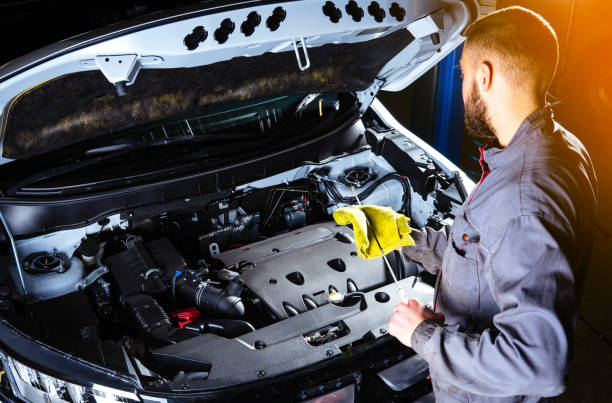The intricacy of modern-day vehicles often makes diagnosing concerns testing for cars and truck owners. Thankfully, automotive innovation has progressed to make this process much faster and extra efficient. One of one of the most beneficial devices auto mechanics count on is the OBD2 scanner. This tool links directly to an automobile's Onboard Diagnostics (OBD-II) system, using critical insights into the health of an automobile and enabling technicians to recognize problems with precision. In this short article, we'll explore how auto mechanics make use of OBD2 scanners to detect automobile troubles and why these tools are crucial for reliable vehicle fixings.
What Is an OBD2 Scanner? An OBD2 scanner is an analysis device utilized to interface with the OBD-II system found in modern-day automobiles. Presented in the mid-1990s, the OBD-II system checks a cars and truck's significant elements, including the engine, transmission, exhaust system, and different sensing units. The system collects data about vehicle efficiency and creates Diagnostic Problem Codes (DTCs) when it discovers an anomaly or malfunction.
![]()
The scanner reviews these codes, which specify to various automobile troubles, and translates them into human-readable language. This allows mechanics to promptly recognize the resource of an issue and begin repairs.
How Auto Mechanics Use OBD2 Scanners to Diagnose Problems. Plugging in the Scanner. Auto mechanics begin the analysis process by plugging the OBD2 scanner into the auto's OBD-II port, which is typically situated under the control panel near the chauffeur's seat. When attached, the scanner interacts with the cars and truck's onboard computer system, drawing up stored mistake codes that suggest specific issues.
![]()
Getting Diagnostic Difficulty Codes (DTCs) The OBD2 scanner recovers diagnostic difficulty codes (DTCs) from the automobile's computer system. These codes are alphanumeric, such as P0300 or P0171, and they are connected to details systems or parts of the car. :
P0300: Random misfires in the engine. P0171: Lean problem (excessive air, not sufficient fuel) P0440: Evaporative emission control system malfunction. Each code assists the mechanic limit the possible root causes of the issue and gives a jumping-off point for further investigation.
Translating and Evaluating the Codes. While the DTCs provide mechanics a base, translating them requires know-how. For instance, a P0420 code could describe a defective catalytic converter, yet it might additionally be caused by a malfunctioning oxygen sensing unit. Technicians use their knowledge of automobile systems to evaluate the codes and determine which component needs focus.
Performing Additional Evaluating. After examining the codes, the technician might execute extra examinations to verify the medical diagnosis. For instance, they might inspect particular sensors, check gas stress, or do compression examinations on the engine. Live data surveillance is an additional essential function of OBD2 scanners. This allows auto mechanics to check out real-time data from different elements (such as fuel injectors, air consumption, or exhaust systems) and assess how the car is carrying out under typical operating conditions.
Clearing Up Codes and Testing the Repair. Once the issue has been identified and repaired, the technician makes use of the OBD2 scanner to remove the codes from the car's system. This makes certain that the trouble has been fixed, and the vehicle will certainly no longer cause cautioning lights like the check engine light. The mechanic might after that check the car once again to ensure every little thing is functioning correctly.
Why OBD2 Scanners Are Necessary for Car Diagnostics. Time-Saving. By promptly reading the error codes from a lorry's OBD-II system, mechanics can swiftly identify the trouble, saving considerable time contrasted to typical methods of detecting problems.
Cost-efficient Fixes. With OBD2 scanners, technicians can prevent the uncertainty included in identifying vehicle issues. This leads to much more exact repair work and fewer unneeded components substitutes, saving both money and time for the cars and truck proprietor.
Proactive Upkeep. OBD2 scanners not just help identify present problems but likewise help in preventative maintenance. Technicians can scan the car to look for small issues before they advance into major, a lot more costly repair work. Regular scans can extend the life of an automobile and ensure it runs efficiently.
Detailed Automobile Tracking. OBD2 scanners permit technicians to keep track of the health of a lorry's significant elements in real time. This detailed tracking ensures that all systems are operating appropriately and aids stop concerns before they trigger significant damages.
Usual Issues Determined by OBD2 Scanners. OBD2 scanners are reliable at identifying a large range of automobile issues, consisting of:
Engine Misfires: Recognized by codes like P0300 (arbitrary misfires) or P0301 (misfire in cylinder 1) Gas System Issues: Troubles like a lean or rich fuel mixture can be found by codes like P0171 or P0172. Discharges Troubles: Codes like P0420 can indicate concerns with the catalytic converter or oxygen sensors. Transmission Issues: Transmission codes such as P0700 can suggest troubles with shifting or equipment interaction. Sensor Failures: Faulty sensors, such as oxygen or mass air flow sensors, are frequently detected through OBD2 codes. Conclusion. OBD2 scanners have reinvented the method auto mechanics diagnose cars and truck problems. With the proceeded advancement of auto innovation, OBD2 scanners will continue to be a crucial tool for keeping vehicles running efficiently and dependably for years to come.
What Is an OBD2 Scanner? An OBD2 scanner is an analysis device utilized to interface with the OBD-II system found in modern-day automobiles. Presented in the mid-1990s, the OBD-II system checks a cars and truck's significant elements, including the engine, transmission, exhaust system, and different sensing units. The system collects data about vehicle efficiency and creates Diagnostic Problem Codes (DTCs) when it discovers an anomaly or malfunction.

The scanner reviews these codes, which specify to various automobile troubles, and translates them into human-readable language. This allows mechanics to promptly recognize the resource of an issue and begin repairs.
How Auto Mechanics Use OBD2 Scanners to Diagnose Problems. Plugging in the Scanner. Auto mechanics begin the analysis process by plugging the OBD2 scanner into the auto's OBD-II port, which is typically situated under the control panel near the chauffeur's seat. When attached, the scanner interacts with the cars and truck's onboard computer system, drawing up stored mistake codes that suggest specific issues.

Getting Diagnostic Difficulty Codes (DTCs) The OBD2 scanner recovers diagnostic difficulty codes (DTCs) from the automobile's computer system. These codes are alphanumeric, such as P0300 or P0171, and they are connected to details systems or parts of the car. :
P0300: Random misfires in the engine. P0171: Lean problem (excessive air, not sufficient fuel) P0440: Evaporative emission control system malfunction. Each code assists the mechanic limit the possible root causes of the issue and gives a jumping-off point for further investigation.
Translating and Evaluating the Codes. While the DTCs provide mechanics a base, translating them requires know-how. For instance, a P0420 code could describe a defective catalytic converter, yet it might additionally be caused by a malfunctioning oxygen sensing unit. Technicians use their knowledge of automobile systems to evaluate the codes and determine which component needs focus.
Performing Additional Evaluating. After examining the codes, the technician might execute extra examinations to verify the medical diagnosis. For instance, they might inspect particular sensors, check gas stress, or do compression examinations on the engine. Live data surveillance is an additional essential function of OBD2 scanners. This allows auto mechanics to check out real-time data from different elements (such as fuel injectors, air consumption, or exhaust systems) and assess how the car is carrying out under typical operating conditions.
Clearing Up Codes and Testing the Repair. Once the issue has been identified and repaired, the technician makes use of the OBD2 scanner to remove the codes from the car's system. This makes certain that the trouble has been fixed, and the vehicle will certainly no longer cause cautioning lights like the check engine light. The mechanic might after that check the car once again to ensure every little thing is functioning correctly.
Why OBD2 Scanners Are Necessary for Car Diagnostics. Time-Saving. By promptly reading the error codes from a lorry's OBD-II system, mechanics can swiftly identify the trouble, saving considerable time contrasted to typical methods of detecting problems.
Cost-efficient Fixes. With OBD2 scanners, technicians can prevent the uncertainty included in identifying vehicle issues. This leads to much more exact repair work and fewer unneeded components substitutes, saving both money and time for the cars and truck proprietor.
Proactive Upkeep. OBD2 scanners not just help identify present problems but likewise help in preventative maintenance. Technicians can scan the car to look for small issues before they advance into major, a lot more costly repair work. Regular scans can extend the life of an automobile and ensure it runs efficiently.
Detailed Automobile Tracking. OBD2 scanners permit technicians to keep track of the health of a lorry's significant elements in real time. This detailed tracking ensures that all systems are operating appropriately and aids stop concerns before they trigger significant damages.
Usual Issues Determined by OBD2 Scanners. OBD2 scanners are reliable at identifying a large range of automobile issues, consisting of:
Engine Misfires: Recognized by codes like P0300 (arbitrary misfires) or P0301 (misfire in cylinder 1) Gas System Issues: Troubles like a lean or rich fuel mixture can be found by codes like P0171 or P0172. Discharges Troubles: Codes like P0420 can indicate concerns with the catalytic converter or oxygen sensors. Transmission Issues: Transmission codes such as P0700 can suggest troubles with shifting or equipment interaction. Sensor Failures: Faulty sensors, such as oxygen or mass air flow sensors, are frequently detected through OBD2 codes. Conclusion. OBD2 scanners have reinvented the method auto mechanics diagnose cars and truck problems. With the proceeded advancement of auto innovation, OBD2 scanners will continue to be a crucial tool for keeping vehicles running efficiently and dependably for years to come.
Navigation
Home
Latest Posts
Celebrating Quality and Community Influence
Published Apr 25, 25
1 min read
Boost Your Small Company with Mercedes-Benz Incentives
Published Apr 25, 25
1 min read
Why Choose a Certified Pre-Owned Automobile?
Published Apr 25, 25
1 min read